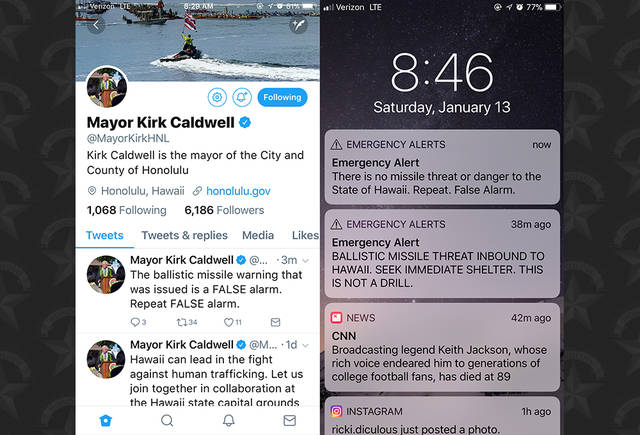State had no safeguards to prevent nuclear scare, FCC says

Tweets from Honolulu Mayor Kirk Caldwell and the mobile messages on the false missile threat alerts.
The chairman of the Federal Communication Commission said today Hawaii did not have “reasonable safeguards in place” to prevent Saturday’s false alert of an imminent missile attack.
“The false emergency alert sent yesterday in Hawaii was absolutely unacceptable. It caused a wave of panic across the state—worsened by the 38-minute delay before a correction alert was issued,” Ajit Pai, FCC chairman said today in a statement. “Moreover, false alerts undermine public confidence in the alerting system and thus reduce their effectiveness during real emergencies.”
RELATED
>> Botched test of alert system leads to 38 minutes of terror
>> Alarm’s impact on tourism remains unclear amid widespread publicity
>> Questions raised on effectiveness of planning for extremely unlikely event
>> Public fury could mean trouble for Ige’s re-election
>> Isle residents seek shelter and answers
>> Pro golfers’ tweets mar isles’ image as serene locale
>> Somebody needs to get fired over false missile alarm
>> Messages of love, anger and relief spread far and wide
On Saturday, residents and tourists in Hawaii spent a 38 terrifying minutes thinking that a nuclear attack was imminent all because a state employee in a Diamond Head bunker clicked his mouse twice. The mistake terrified many in Hawaii and elsewhere and left them questioning the credibility the government that they count on to protect them from geopolitical woes like heightened tensions with North Korea.
About three minutes after an 8:05 a.m. alert went out, the head of the Hawaii Emergency Management Agency, state Adjutant Maj. Gen. Joe Logan, verified with U.S. Pacific Command that there was no launch and notified Honolulu police. Thirteen minutes after the erroneous text, HEMA finally posted to Facebook and Twitter that it was a false alarm, but it would take another 25 minutes for a correction text alert to go out at 8:45 a.m.
Pai said the FCC’s investigation into the incident is well underway and the agency has been in close contact with federal and state officials, gathering the facts about how Hawaii’s false alert was issued.
Don't miss out on what's happening!
Stay in touch with breaking news, as it happens, conveniently in your email inbox. It's FREE!
“Based on the information we have collected so far, it appears that the government of Hawaii did not have reasonable safeguards or process controls in place to prevent the transmission of a false alert,” he said.
Vern Miyagi, administrator for HEMA, said Saturday that the agency had to wait to make the retraction until it had authorization from the Federal Emergency Management Agency.
Governor David Ige said Saturday that the state didn’t have a process in place to issue a cancellation and the correction had to be done manually after receiving federal approval.
Pai said steps must be taken to prevent a similar incident from happening again.
“Federal, state, and local officials throughout the country need to work together to identify any vulnerabilities to false alerts and do what’s necessary to fix them. We also must ensure that corrections are issued immediately in the event that a false alert does go out,” he said.





